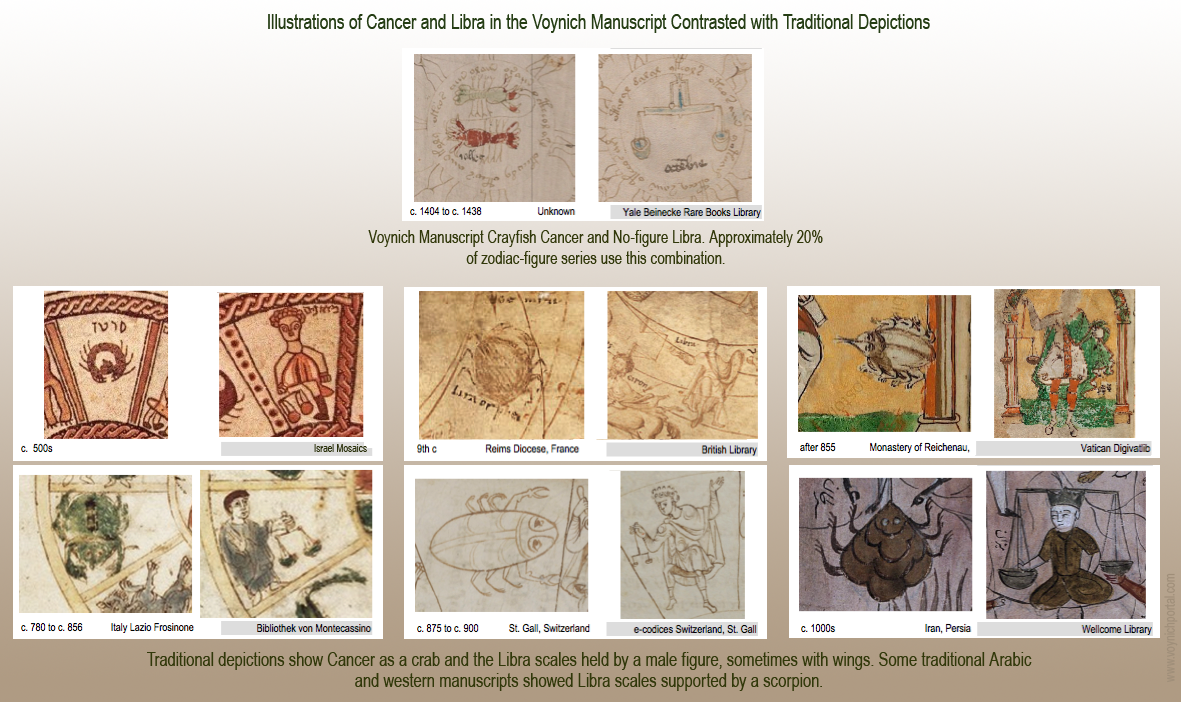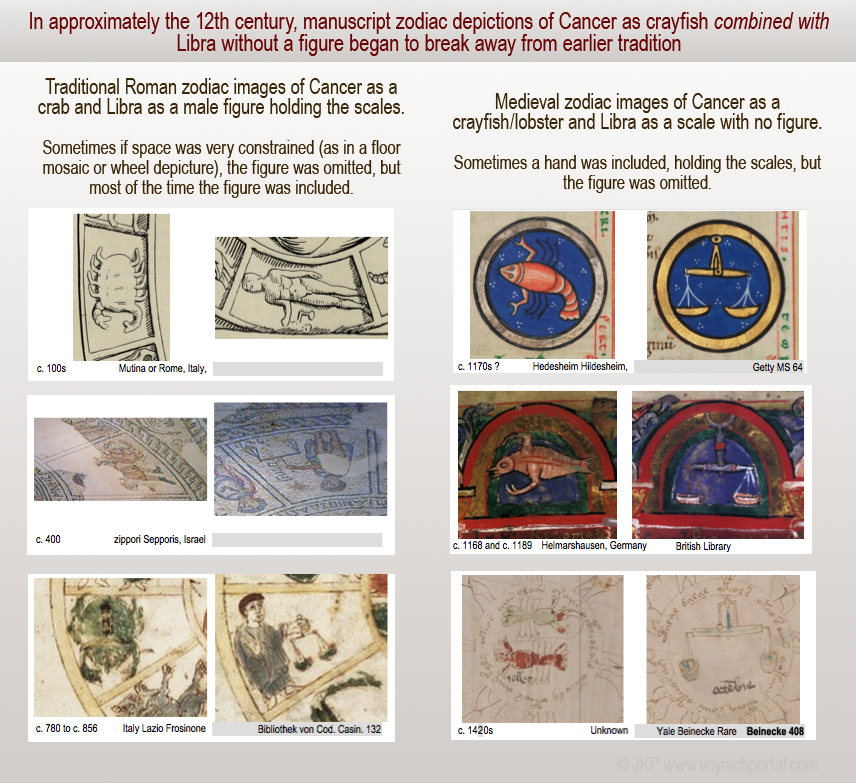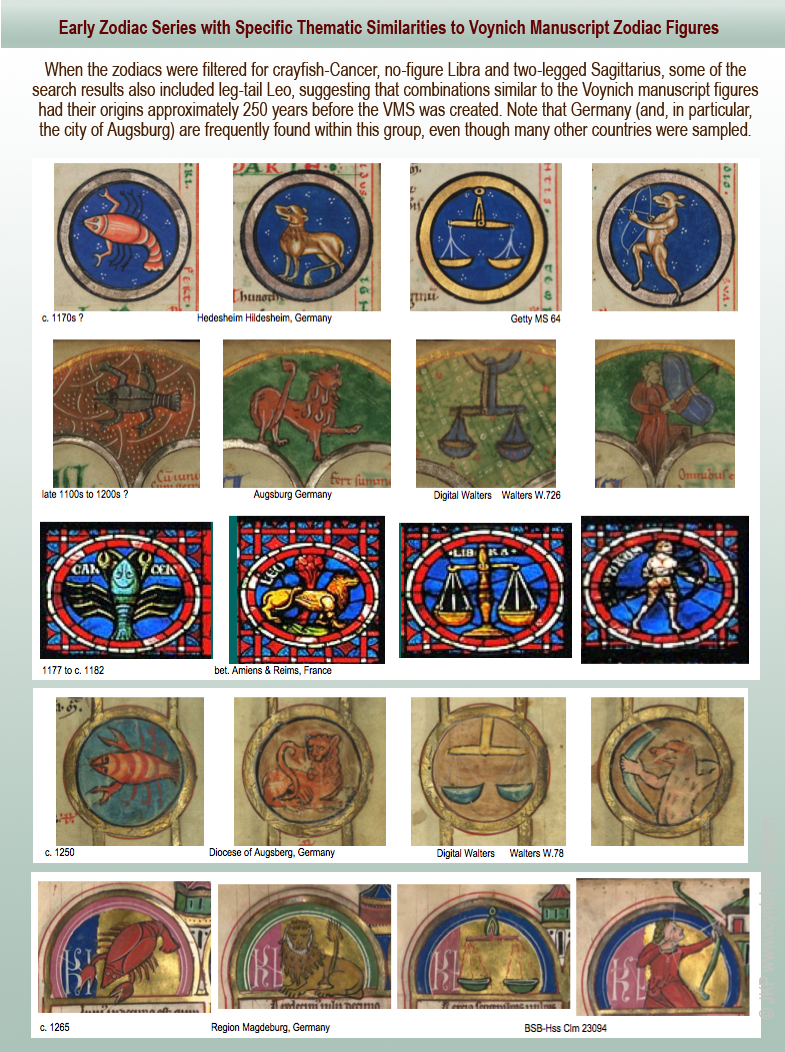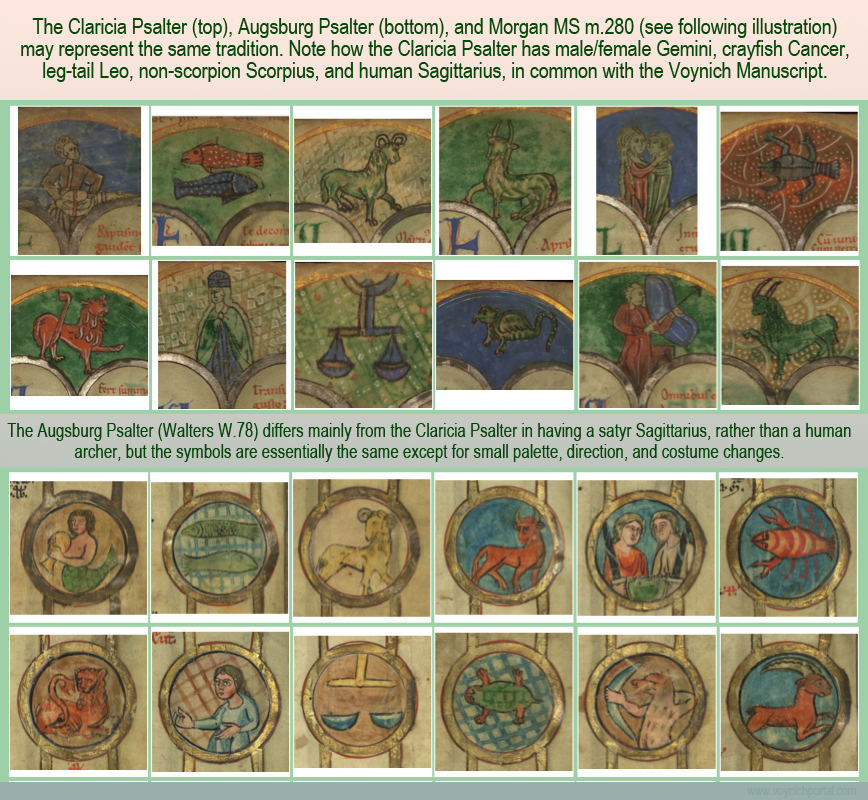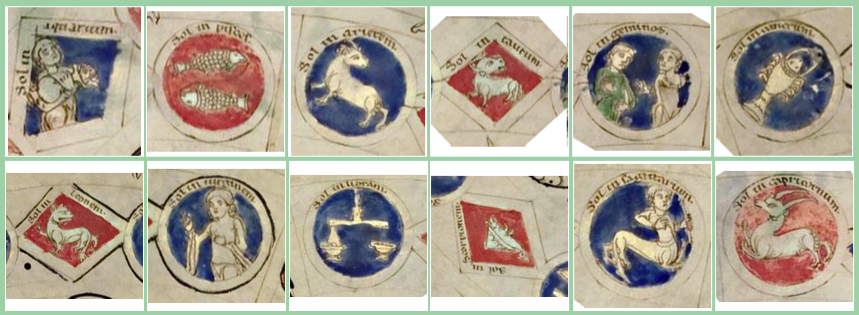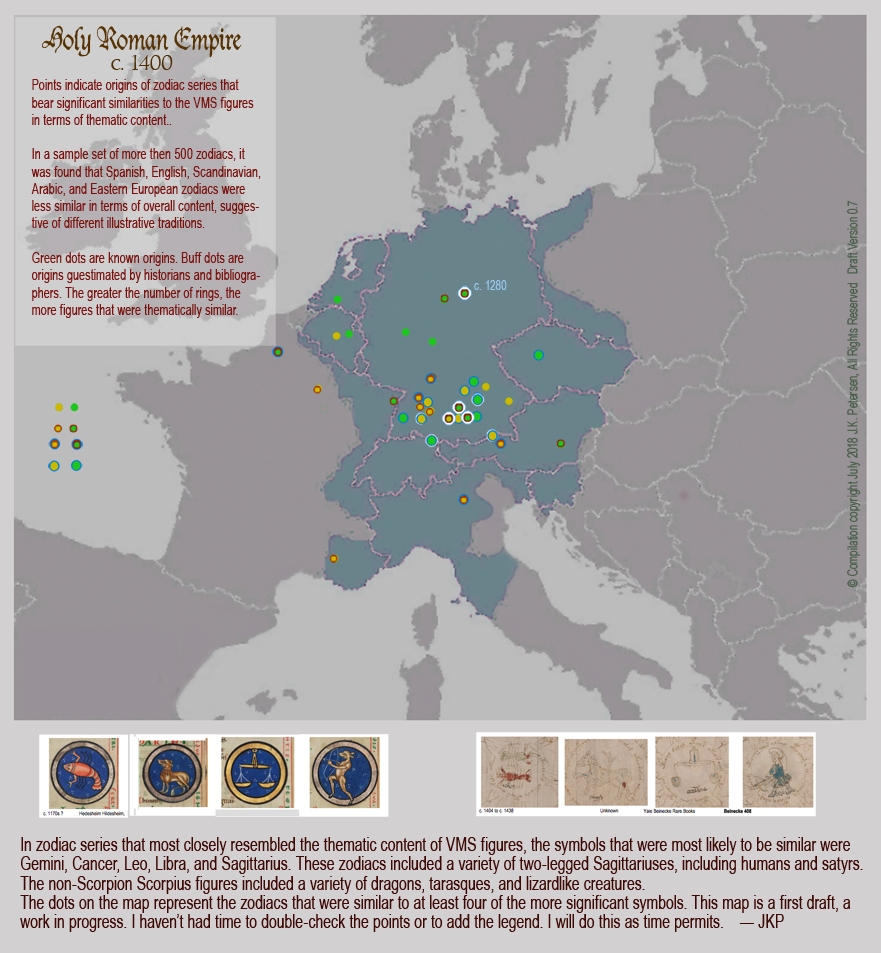After collecting more than 500 zodiac series and analyzing their patterns, it becomes apparent that the VMS zodiac figures are consistent with thematic traditions from central Europe ranging from the late 12th century to the early 15th century.
Discovering this goes far beyond comparing images. Traditions and thematic families allow leeway for personal expression. For example, colors or the direction in which an animal is facing were not always slavishly copied by illustrators and do not appear to negate a thematic relationship to other zodiacs. Considerable study was necessary to determine which details are significant and what can be expected to vary within a reasonable range without straying outside the pattern.
The VMS only includes 10 of the 12 figures that are traditionally found in figurative representations of “zodiacs”, symbols of constellations that occur along the ecliptic, so Aquarius (water bearer) and Capricorn (the goat) were excluded from searches.
The Difference Between Classical Zodiacs and A Subset of Medieval Zodiacs
Classical drawings of zodiac figures depict Cancer as a crab and Libra as a figure holding the scales or sitting on top of the scales. Most of the Roman carvings, and the Beit Alpha mosaics, follow this model, as do 11th- and 12-century friezes in Spain and France. Here are some early examples that illustrate how the VMS departs from classical tradition by using a crayfish instead of a crab and a scale with no figure:
Occasionally, when space was constrained, the Libra scales were drawn without a figure, but those in manuscripts were usually held by a male figure, or by a scorpion. Similarly, Virgo was usually male. Virgo and/or Libra were sometimes drawn with wings. As time went on, a female was gradually substituted for the male and wings were less often included.
Patterns that Relate to the VMS
I have already posted some “combination searches” in previous blogs. This one attempts to zero in on which relationships to other manuscripts are the most crucial.
Using a sample of 520 medieval zodiac series, only 25% were found to depict Cancer as a crayfish/lobster together with Libra scales without a figure. This break with tradition may have originated in church portal sculpture, but appears to have entered manuscripts sometime around the 12th century:
This puts the VMS in the thematic minority. If we filter the zodiacs further, to exclude Sagittarius with four legs, it reduces the number to 6%.
What is particularly interesting is that this added filter does not change the approximate date range of early examples that break with tradition in the same ways as the VMS and, as an added bonus, the following 12th-century examples also include Leo with his tail wound between his legs. When a pattern like this occurs naturally, without explicit filtering, it is usually not a coincidence:
Some of the zodiacs from this time period match the first three filters, but continue to use the traditional 4-legged centaur to represent Sagittarius. Those with a centaur have proportionately fewer Leos with the tail between the legs. Even though the two sets are regionally similar (primarily Germany and, to some extent France), this may be the beginning of two separate branches.
This series from southern Germany is incomplete (Libra is missing) but it shows that even zodiacs that are drawn quite differently can follow the same thematic patterns:
Note that by the 14th century, leg-tail Leo was paired with centaur-Sagittarius more often than in earlier manuscripts. Traditions don’t always diverge, sometimes they go the other way, as well.
When did Cancer as a crayfish emerge?
Some might say Cotton MS Galba A XVIII (9th c) is the first crayfish, but it’s very oddly drawn, with two heads, and it was very rare for English manuscripts to include a crayfish, most of them are crabs. It is possible that it’s not from England (historians aren’t sure). Many manuscripts in English collections are thought to be from Normandy.
Badly drawn crabs sometimes look like crayfish, but one of the earliest unambiguous crayfish is in Vatican Reg.lat.123 from St. Maria Rivipulli/Ripoll monastery, Catalonia, Spain (mid-11th century).
Crayfish were historically abundant in this area and are still featured on many menus, so perhaps that’s why they substituted a crayfish for a crab. However, as can be seen from the image above, the rest of the zodiac series is completely traditional, and the scales are carried by a winged figure. Other than the crayfish, it doesn’t resemble the VMS.
Taking Cancer and Libra Together
One of the earliest examples that includes both crayfish-Cancer and no-figure Libra is the Stammheim Missal, originating in Hildesheim, Germany, c. 1170s. I have mentioned this before because it has other commonalities with the VMS (including two-legged Sagittarius, and Leo with the tail through the legs). It doesn’t match on all counts, but it’s one of the earliest manuscripts that hints at the transition to VMS-like zodiacs,. Note that the figures are contained within roundels:
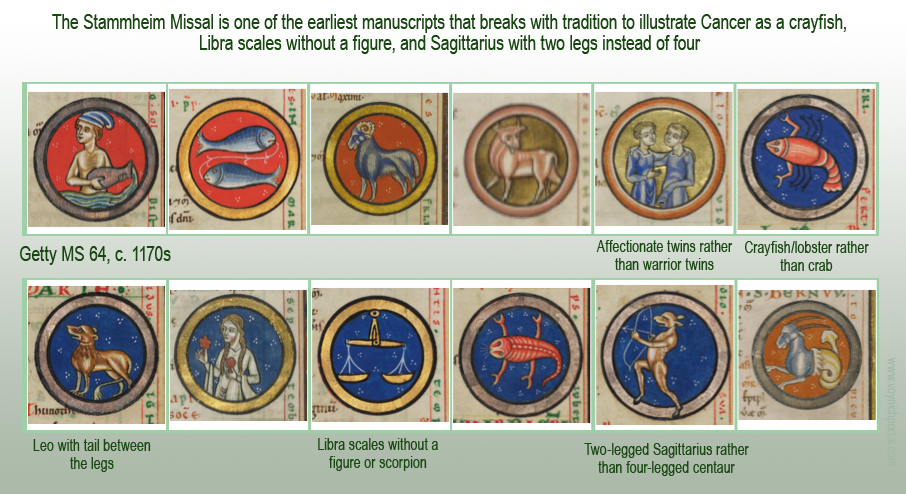 There is a Psalter fragment in the British Library (Landsowne 381) created around the same time as the Stammheim Missal that has similar Cancer, Libra, and leg-tail Leo, but the twins are dressed in Roman garb and are not touching, and Sagittarius is a four-legged centaur.
There is a Psalter fragment in the British Library (Landsowne 381) created around the same time as the Stammheim Missal that has similar Cancer, Libra, and leg-tail Leo, but the twins are dressed in Roman garb and are not touching, and Sagittarius is a four-legged centaur.
What about Gemini?
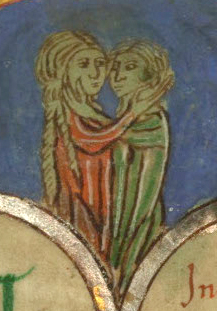
I’ve mentioned the Claricia Psalter numerous times because it has much in common with the VMS. In addition to crayfish Cancer and no-figure Libra, it has a leg-tail lion, one of the first overtly affectionate male-female Geminis, a human Sagittarius, and a non-scorpion Scorpius. It originated in Augsburg, Germany, in the 12th or 13th century. In terms of the basic “template”, it differs very little from the VMS and is clearly modeled on the same themes as the Augsburg Psalter. I’ll repost the images:
Note how the goat and the ram are painted different colors, the turtle/tarasque is from a different angle, and the bull and goat are facing the other way, and yet the overall thematic similarities are striking.
Augsburg is in southern Germany, not far from where Hildegard von Bingen created these zodiac figures:
Hildegard von Bingen’s zodiac series (c. 1200) features crayfish-Cancer, no-figure Libra, and non-scorpion Scorpius, but Sagittarius is a traditional centaur, and Leo’s tail does not thread through the legs, which makes it more similar to the Oettingen Psalter (BVB Cod.I.2.4.19) and the Bambergher Psalter than the VMS.
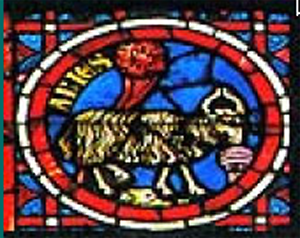 You may have noticed that the Soissons Cathedral windows are quite similar to the VMS and even include trees in the background, but some of the glass has been replaced and it’s difficult to know if the new glass mimicked designs from the 12th century or updated them. If the designs are faithful to the original, they follow a similar model to the VMS, including leg-tail Leo and two-legged Sagittarius, as discussed in my earlier posts on the evolution of zodiacs. It even looks like Aries might be nibbling from a bush or a basket.
You may have noticed that the Soissons Cathedral windows are quite similar to the VMS and even include trees in the background, but some of the glass has been replaced and it’s difficult to know if the new glass mimicked designs from the 12th century or updated them. If the designs are faithful to the original, they follow a similar model to the VMS, including leg-tail Leo and two-legged Sagittarius, as discussed in my earlier posts on the evolution of zodiacs. It even looks like Aries might be nibbling from a bush or a basket.
The use of a crossbow rather than a longbow probably represents a sub-branch or may, in some cases, be a simple matter of illustrator choice (crossbow tournaments were popular at the time). The most important distinction for this sign appears to be the number of legs rather than the kind of bow. Whether Sagittarius is human or satyr also appears to be less important than the number of legs.
The Origins of the Traditions
I’ve created a map to show the origins of manuscripts that emerged with these filters. This is a work in progress and I have not yet double-checked the datapoints, but they are accurate enough to show that zodiacs, when filtered for Crayfish-Cancer, no-figure Libra, 2-leg Sagittarius, and leg-tail Leo, are conspicuously clustered within the Holy Roman Empire and very conspicuously absent from England, Scandinavia, Spain, southern Italy, southeast Europe and the Middle East (at least so far).
Summary
I’ve mentioned these zodiacs in previous articles and can’t present all the pictures because there are too many for one blog, but I did want to emphasize this: the data tells us that the VMS fits comfortably within existing traditions, particularly those in Germany and northeastern France and Flanders.
This doesn’t reveal where the creators of the VMS were from, but it does suggest that at least one of them was familiar with specific illustrative themes and probably copied the ideas (not necessarily the drawings) from one or more zodiac-series exemplars that originated between c.1170 to c.1430. Some of the English zodiacs are similar, but they differ from the VMS in favoring a centaur-Sagittarius, and Gemini as nude male twins.
If you filter even further to include affectionate Gemini and non-scorpion Scorpio, north-central Germany comes closer than England or France:
Examples from 13th-century Augsburg and Magdeburg/Hildesheim are particularly significant. In fact, these somewhat distant locations might indicate an important line of transmission between north and south.
J.K. Petersen
© Copyright 2018 J.K. Petersen, All Rights Reserved

